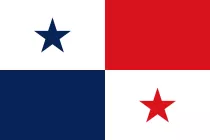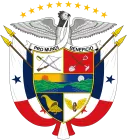Panama

Geographical Location of Panama
Panama is in transition between North and South America, connecting the two continents together. It is a so-called transcontinental country because it extends across several continents. The landscape is characterized by jungle along the coast and mountain ranges to the east and west. Savannas occur in arid areas. The climate is tropical, with high humidity and high temperatures all year round. Along the Pacific coast, temperatures are somewhat cooler. Almost all precipitation falls during the rainy season from May to December.
Panama is struggling with a number of environmental problems related to deforestation and agriculture. Deforestation has led to desertification of dry areas, loss of wildlife habitat and destruction of wetlands. In addition, the deforestation of the rainforests has caused soil and dirt to be washed away by rain and wind. This led to the re-closure of the Panama Canal, as well as high levels of pesticides, artificial fertilizers and pollution from washed-away soil in marine waters. Agricultural sprays and fertilizers have also led to significant pollution of rivers, streams and drinking water.
Brief History of Panama
Panama's location between North and South America has made it an important transit country for different peoples and civilizations. The Spanish crossed the narrow tongue separating the Atlantic from the Pacific in the early 16th century as the first Europeans. At that time, this area was sparsely populated. A strategically important crossing point for the world's oceans, the area became the center of the Spanish Empire in Central America for over 300 years. Most of the indigenous people were exterminated after the arrival of Europeans, mainly due to slavery and new introduced diseases. In 1821, Panama was incorporated into the Republic of Gran Colombia, and in 1903 it gained independence.
Beginning in the 1870s, there were repeated attempts to build a canal to carry ships from the Atlantic to the Pacific via Panama. The country's dense rainforests and swamps have led to tropical diseases such as malaria killing tens of thousands of workers. It was not until 1914, when the United States purchased the land between the seas, that the canal was realized. Since then, the country has struggled with an unstable political situation. Panama was ruled by various military dictatorships between 1968 and 1989. The US invaded the country in 1989 and overthrew incumbent dictator Manuel Noriega. The UN General Assembly made it clear that the invasion was a clear violation of international law. The United States has had great influence over Panama's politics since independence, and owned and controlled the Panama Canal until 1999.
Society and Politics of Panama
Panama is a republic and parliamentary democracy. The president is both head of state and head of government and is elected every five years. The National Assembly (parliament) is also elected for a term of five years from local constituencies. The country is grappling with widespread corruption that has led to widespread contempt for politicians. The military has historically played a very powerful role in society and politics, and the president remains dependent on military support to govern.
The main political concerns relate to corruption and the country's reputation as a tax haven, meaning it offers low taxes and little regulation for foreign companies and individuals. Despite efforts to reduce corruption, the problem remains widespread. The country's reputation as a tax haven has also persisted despite political efforts to tighten regulations in the financial sector.
The society is characterized by huge inequalities between rich and poor. Social benefits such as health insurance and pensions apply mainly to those in formal employment, meaning that almost one in three Panamanians are not covered. The health care system is well developed in large cities, but has serious deficiencies in rural areas. Domestic violence against women and sex trafficking are common crimes that are rarely prosecuted.
Economy and Trade of Panama
Panama has little industry, and about 80 percent of the country's income comes from the service sector. Most of the revenue comes from industries related to the Panama Canal, such as tolls, passenger taxes, freight, hotels and ship supplies. The liberal establishment and tax arrangements gave the country significant international banking and insurance business. For this reason, many foreign companies have their headquarters in Panama, which has given the country a reputation as a tax haven. About one in five Panamanians works in agriculture, where production is low and incomes are low. The main crop grown is bananas, which also account for about a third of exports. The country has a large trade deficit.
Despite extensive social reforms in recent decades, more than 15 percent of the population lives below the national poverty line. Per capita income is higher than many other countries in the region, but inequality between rich and poor is among the largest in the world. Poverty is most prevalent in rural areas, where indigenous people are in the majority, and among populations descended from African slaves. Panama was one of the countries with the strongest economic growth in Latin America and the Caribbean before the corona pandemic occurred, but the pandemic has slowed economic development and led to increased poverty in the country.







